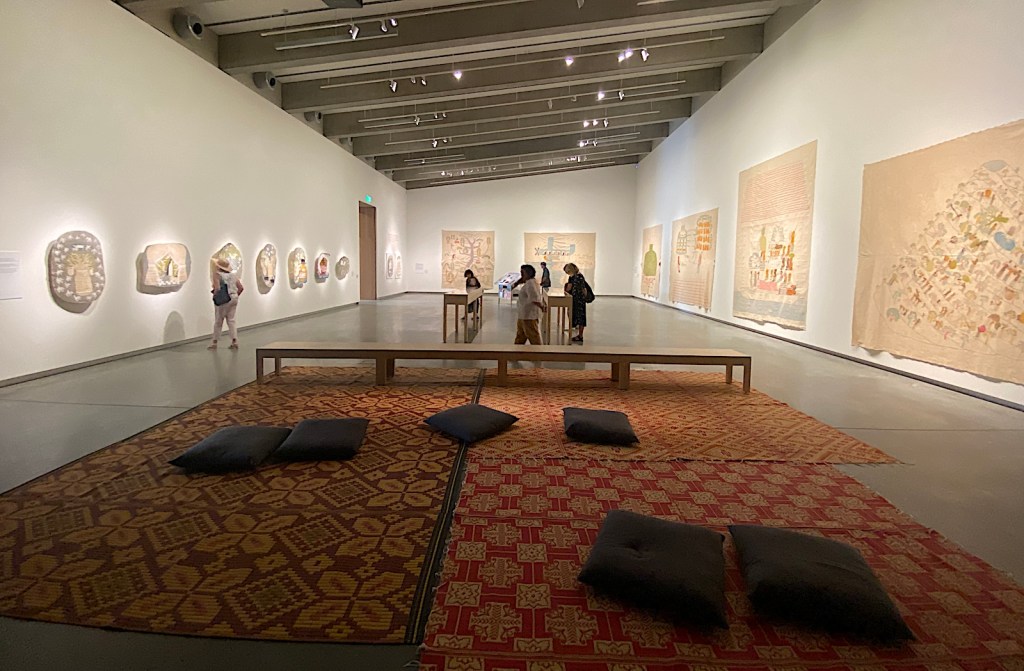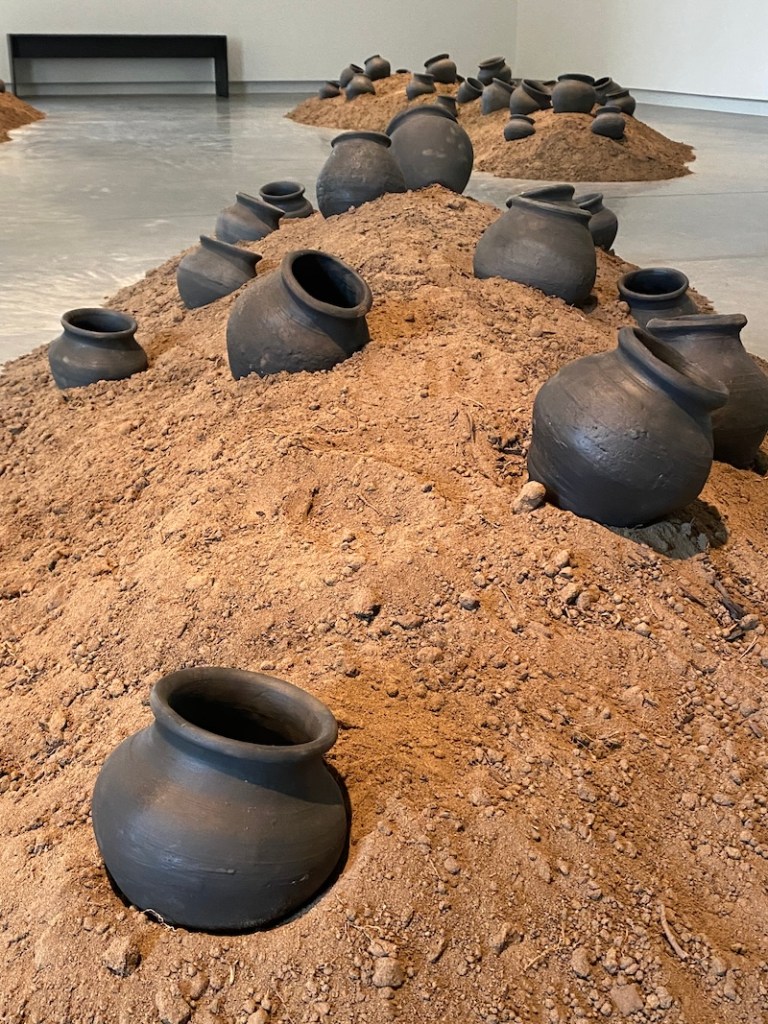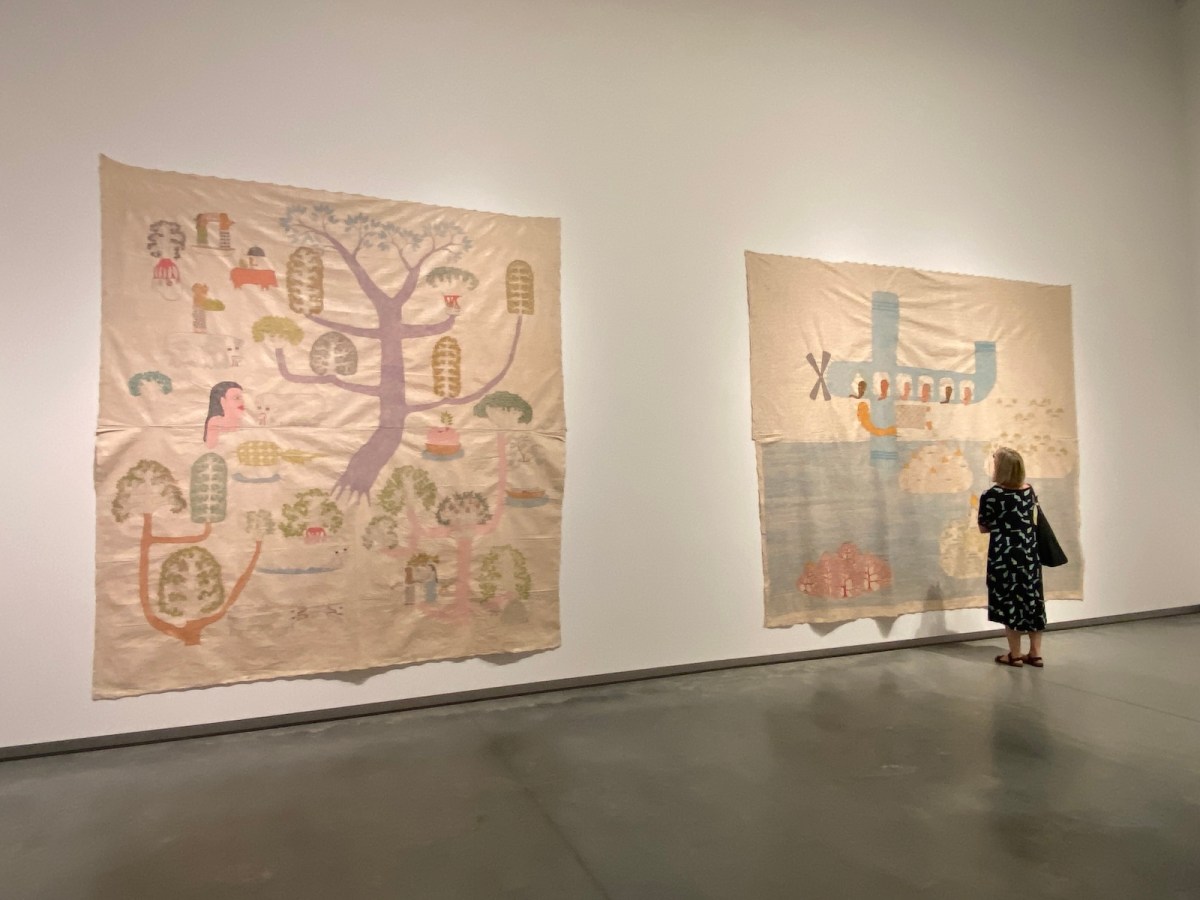Land and sea connect many of us – geographically, but also culturally. Bundanon’s latest exhibition explores those points of connection across three interconnected exhibitions, which are both intergenerational and collaborative.
In many ways, these are three stand-alone projects, but together, they create a wider conversation about storytelling – personal narratives, as well as those bigger narratives of diaspora, and mythological stories that are innately shared.
Bundanon’s Main Gallery has been handed over to Indonesian-Australian artist Jumaadi with a survey exhibition, titled ayang–ayang (or shadow-shadow). The work spans about a decade, and is supplemented with new work made while in residence at Bundanon.
That new shadow play, titled The Sea is Still a Mystery, sits as an anchor in the space and draws upon nature as a repository of historical and natural events. The music has been composed by sound artist Michael Toisuta. Cushions have been thrown on the floor and a massive screen draws viewers in to pause and watch. (It will also be performed as part of an exhaustive public program over the next month.)

Central to this gallery are two long museum cases containing hand-drawn books by the artist, which unfurl in a concertina format and refer to the shadow play narrative. Around the walls are huge painted cloth works inspired by the Kamasan tradition of East Bali. Typically the figures are flattened, echoing their shared roots with shadow play.
These are incredibly impressive works by Jumaadi, and correspond – on an opposite wall – with buffalo hide cutouts, using the traditional shadow material and techniques with a contemporary inflection.
What makes these so “connectable” and enjoyable for audiences is that they are stories of love, life and humanity. They have a floating dream-like narrative and yet are rooted in shared everyday experiences.
This blur of the personal and the epic link back to Arthur Boyd’s own interest in mythology. A trigger point to the Sangkuriang exhibition (which is presented in the second gallery), was a suite of relatively unknown and significant works from the Bundanon Collection, which Boyd made in 1993 in collaboration with West Javanese artist and printmaker Indra Deigan.
There has been criticism of Bundanon for not permanently showing Boyd’s work, and this dive into the Collection comes with the announcement that a small permanent space will be opened later this year.
The books are a really interesting, little-known aspect of Boyd’s practice in terms of collaboration and pulling on this really big Indonesian story, which is very culturally specific, but at the same time resonates with those big mythological stories around the world.
Ten editions of the book were made, all hand-bound and individually printed, making each slightly different. Three are in the Bundanon Collection; another from the National Library’s Collection is also on display.
The Gallery has additionally digitised them, so you can turn the pages on a flat screen within the exhibition, or access them via a QR code for a deeper read later. It is fabulous to think that a story dating back to the 15th century can be so accessible for today’s audiences.
That coupling, is further explored in Gallery Three, in a collaborative project by Sancintya Mohini Simpson and her brother, sound artist Isha Ram Das.

Simpson has used three tonnes of earth from the Bundanon site to create an installation that speaks about indentured labour, and her descendants sent from India to work on colonial sugar plantations in South Africa. It is a story familiar to Australia.
Titled par-parā/phus-phusā (to speak incessantly/to whisper), it comprises beautiful earthenware vessels in a Southern Indian style, which sit in the earth with little speakers inside. They become resonant chambers. Their blackened patina suggests the burnt sugar cane. It is a beautiful, meditative piece.
The second part of the project is a suite of geometric works on paper, drawn with sugar cane ash and black pigment. They are based on Kōlaṁ designs – traditionally made from rice flour by South Indian women and placed at the entryways to homes. Their repetitive line work is both meditative and ritualistic – but that ritual is one of daily practice and is largely unseen or invisible. Their simplicity is modest and yet they have a presence that is commanding.
Read: Exhibition review: Laure Prouvost: Oui Move In You, ACCA
Ritual and reflection are key to all these works; they can be part of a healing process, or simple everyday regenerative practice. A collection of works in the smaller corridor gallery reminds us that these practices are timeless.
Silk runners from Jumaadi’s personal collection sit opposite works made while in residence at Bundanon. Their format is almost a metaphor for the timeless persistence of narrative through land and life. There is a lot doubling across this exhibition – whether it’s through actual collaboration of artists, or objects and shadow with Jumaadi’s work, or siblings, or time.
This is a beautifully curated exhibition by Bundanon CEO Rachel Kent, who has had long relationships with both Jumaadi and Simpson, and brings that depth of connection with their practice to this show.
Tales of Land and Sea, Bundanon Art Museum
Shoalhaven, regional NSW, until 16 June; ticketed.
Learn more about the full live program to accompany this exhibition.





